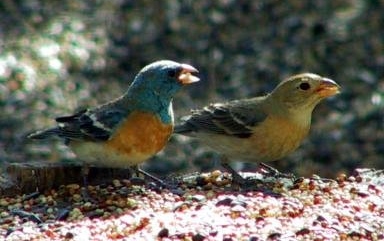|
Small
finch, bright blue upperparts,
cinnamon-brown breast and sides, white belly.
Dark wings with white wing bar.
Forages on ground, low in trees and bushes.
Eats seeds, insects, caterpillars. Short flights, alternates rapid
wing beats with brief periods of wings pulled to the sides.

|
LAZULI
BUNTING
Passerina amoena
PASSERIFORMES
Cardinals and Grosbeaks (Cardinalidae)
Range
and Habitat
Breeds from British Columbia, Saskatchewan, and
North Dakota south through western U.S. to southern California, northern
New Mexico, western Oklahoma, and eastern Nebraska. Spends winters south
of the U.S.-Mexico border.
Preferred habitats include dry, brushy ravines and slopes,
as well as cleared areas and weedy pastures.
SOUND: "see-see-sweet", "sweet-zee-see-zeer"
Male Lazuli
Buntings two years of age and older sing
only one song, composed of a series of different syllables,
and unique to that individual.

They start their molt during late summer on their breeding grounds,
then stop this molt and migrate to molting areas in southern Arizona,
New Mexico and northern Sonora,
or the southern tip of Baja California where they
finish molting before continuing their migration to
wintering grounds in western Mexico.
A group of buntings are collectively known as a "decoration",
"mural",
and "sacrifice" of buntings.
The Lazuli Bunting is rated as Vulnerable. This rating is a result of
population numbers that have decreased over the past years. Although
it appears that the population of this bird may be increasing in some
areas, it is still considered to be vulnerable to threats. If numbers
continue to increase, it may be downgraded to Near Threatened.
This bird species is native the Marshall Islands, Canada, Mexico, Russia,
the Northern Mariana Islands and the United States. It is thought to
be regionally extinct in Japan. The Lazuli Bunting is sometimes seen
on
Norfolk Island and New Zealand.
|